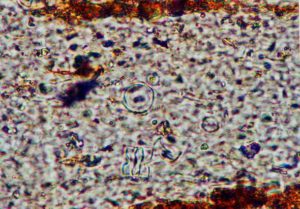Lake McAbee
The rocks and types of fossils we find tell us something about the lake that occurred here 50 million years ago. The thin brown and white layers in the image above are altered diatomite. The fact that the fossils are preserved in diatomite points to deposition in a fairly large lake. Diatomites only form when there is very little input from terrestrial sediments.
The fossil bearing shales are frequently interrupted by coarser layers as seen above. These were deposited by turbidity currents during storms or volcanic ash that was deposited directly into the lake. The total thickness of the shale deposit at McAbee is about 90 meters thick. Lake McAbee probably only existed a few thousands of years and may have disappeared very quickly as the result of a nearby volcanic eruption.


